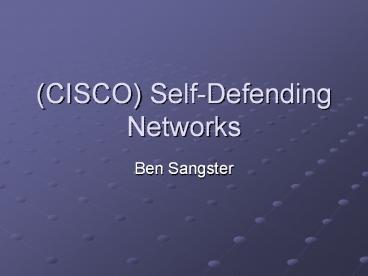(CISCO) Self-Defending Networks - PowerPoint PPT Presentation
Title:
(CISCO) Self-Defending Networks
Description:
(CISCO) Self-Defending Networks Ben Sangster Agenda (CISCO) Self-Defending Network Concept Why do we need SDN s? Foundation of the CSDN? Endpoint Protection ... – PowerPoint PPT presentation
Number of Views:1409
Avg rating:3.0/5.0
Title: (CISCO) Self-Defending Networks
1
(CISCO) Self-Defending Networks
- Ben Sangster
2
Agenda
- (CISCO) Self-Defending Network Concept
- Why do we need SDNs?
- Foundation of the CSDN?
- Endpoint Protection
- Admission Control
- Infection Containment
- Intelligent Correlation and Incident Response
- Inline IDS and Anomaly Detection
- Application Security and Anti-X Defense
- Summary
- Questions
3
Cisco Self-Defending Network (CSDN) Concept
- A systems-based solution that allows entities to
use their existing infrastructure in new ways to - Reduce windows of vulnerability
- Minimize the impact of attacks
- Improve overall infrastructure availability and
reliability
4
CSDN Concept (cont.)
- CSDN also helps create autonomous systems that
can quickly react to an outbreak with little to
no human intervention
5
Why do we need CSDNs?
- Evolution of network?Evolution of attacks on
networks - Traditional approach?Defense-in-depth
- Proactive defense mechanisms
- CSDN approach
- Adaptive defense mechanisms
6
Why do we need CSDNs? (cont.)
- Proactive defense mechanismsnot obsolete, simply
inefficient in responding to breeches in network
security - Proactive solutions frontload defense mechanisms
7
Proactive Defense Example
DMZ
Internet
Outer Firewall
Inner Firewall
8
Why do we need CSDNs? (cont.)
- Adaptive Solutionsfocus isnt solely on
preventing network attacks - Attempt to effectively
- Detect
- Respond
- Recover
- Little to no adverse effect on the network and
its users
9
Why do we need CSDNs? (cont.)
- Key elements of an adaptive solution
- Remain active at all times
- Perform unobtrusively
- Minimize propagation of attacks
- Quickly respond to as-yet unknown attacks
10
Foundation of a CSDN
- Endpoint Protection
- Admission Control
- Infection Containment
- Intelligent Correlation and Incident Response
- Inline IDS and Anomaly Detection
- Application Security and Anti-X Defense
11
Endpoint Protection
- You are only as strong as your weakest link
- One non-sanitized end-user system connected
behind a robust, efficient defense can spell
D-O-O-M for a network - Cisco Security Agent
- Point of presence on end user systems that
enables efficient exchange of valuable network
threat information as it occurs - Endpoint system virus, worm detection/protection
12
Admission Control
- Not only core component of a CSDN, but
incorporated into other technologies by over 30
industry-leading vendors - Network Admission Control (NAC) assists in
determining the level of access to grant an
end-user system in accordance with the security
policy when it initially joins the network - NAC also assists in managing end-user systems
compliance with security patches and updates
13
Infection Containment
- The ability to identify non-compliant systems or
network attacks as they occur and react
appropriately, minimizing the effect of the
breech - Potentially the 1 core component of a secure
system belonging to a CSDN
14
Intelligent Correlation and Incident Response
- Services that provide the ability to exchange
- Event information
- Implications of an event occurring
- Necessary actions to take
- The appropriate nodes or systems to enforce
actions in real-time - These services aide in adapting to changes and
countering attacks that are occurring in the
network as they occur rather than after they occur
15
Application Security and Anti-X Defense
- A menagerie of application layer security
products that address the ever-evolving classes
of threats which are not effectively addressed by
traditional firewall and network IDS products - Threat examples
- E-mail based SPAM and phishing
- Spyware
- Unauthorized peer-to-peer activity
16
Summary
- New phraseology NOT a new technology
- Encompassing security solution that is proactive
AND adaptive in nature that envelopes every level
of network security rather than just specific
layers - Key difference in CSDN and traditional security
solutionsability of CSDNs to communicate and
share information among different security
products employed within the CSDN
17
Questions



























![[Infographic] The MSP Journey to AI/ML-Powered Detection and Response PowerPoint PPT Presentation](https://s3.amazonaws.com/images.powershow.com/9988432.th0.jpg?_=20240117124)



